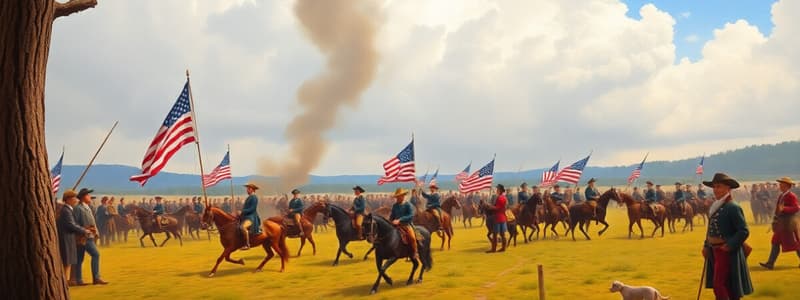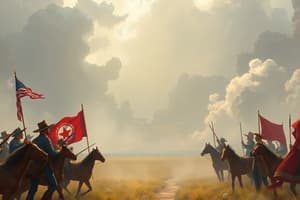Podcast
Questions and Answers
Which of the following was NOT a primary cause of the War of 1812?
Which of the following was NOT a primary cause of the War of 1812?
- Restrictions on American trade by the British navy.
- British impressment of American sailors.
- Territorial disputes over land in the Louisiana Purchase. (correct)
- British support for Native American resistance to westward expansion.
How did the War of 1812 impact the United States?
How did the War of 1812 impact the United States?
- It stimulated American nationalism and manufacturing. (correct)
- It led to a significant decrease in American manufacturing due to British blockades.
- It resulted in the United States ceding territory to Canada.
- It resolved all outstanding territorial disputes with Great Britain.
Which factor most fueled the concept of Manifest Destiny?
Which factor most fueled the concept of Manifest Destiny?
- Desire to limit westward expansion to preserve natural resources.
- Efforts to establish peaceful relations with Native American tribes.
- Fear of overpopulation in eastern cities.
- Belief in American cultural and racial superiority combined with economic opportunities. (correct)
What was a significant consequence of Manifest Destiny?
What was a significant consequence of Manifest Destiny?
What event triggered the secession of Southern states, leading to the Civil War?
What event triggered the secession of Southern states, leading to the Civil War?
What was the primary goal of the Abolition Movement?
What was the primary goal of the Abolition Movement?
What strategy was NOT employed by the Abolition Movement?
What strategy was NOT employed by the Abolition Movement?
What was the main purpose of the 13th, 14th, and 15th Amendments?
What was the main purpose of the 13th, 14th, and 15th Amendments?
Why is the Reconstruction Era considered a complex and contradictory period in American history?
Why is the Reconstruction Era considered a complex and contradictory period in American history?
What event effectively marked the end of the Reconstruction Era?
What event effectively marked the end of the Reconstruction Era?
Flashcards
War of 1812
War of 1812
Conflict between the U.S. and Great Britain (1812-1815) sparked by trade disputes and impressment.
Manifest Destiny
Manifest Destiny
The belief that the U.S. was destined to expand across North America.
Civil War
Civil War
War (1861-1865) fought over slavery and states' rights, resulting in Union victory and slavery's end.
Abolition Movement
Abolition Movement
Signup and view all the flashcards
Reconstruction Era
Reconstruction Era
Signup and view all the flashcards
Treaty of Ghent
Treaty of Ghent
Signup and view all the flashcards
Treaty of Guadalupe Hidalgo
Treaty of Guadalupe Hidalgo
Signup and view all the flashcards
Emancipation Proclamation
Emancipation Proclamation
Signup and view all the flashcards
Underground Railroad
Underground Railroad
Signup and view all the flashcards
13th, 14th, and 15th Amendments
13th, 14th, and 15th Amendments
Signup and view all the flashcards
Study Notes
- The period between 1812 and 1870 in American history was marked by significant transformations, including territorial expansion, sectional conflict, and the reshaping of American society.
War of 1812
- The War of 1812 was fought between the United States and Great Britain from 1812 to 1815.
- Causes included British impressment of American sailors, restrictions on American trade, and British support for Native American resistance to westward expansion.
- Key events included the burning of Washington D.C. in 1814 and American victories at sea and at the Battle of New Orleans in 1815.
- The Treaty of Ghent ended the war, but also resolved the issues that led to the war.
- The war stimulated American manufacturing and nationalism.
Manifest Destiny
- Manifest Destiny was the belief that the United States was destined to expand across the North American continent.
- Fueled by economic opportunities, population growth, and a sense of cultural and racial superiority.
- Key events included the annexation of Texas in 1845, the Mexican-American War (1846-1848), and the acquisition of vast territories from Mexico in the Treaty of Guadalupe Hidalgo.
- Led to debates over the expansion of slavery into new territories, intensifying sectional tensions.
Civil War
- The Civil War (1861-1865) was fought between the United States (the Union) and the Confederate States of America.
- Secession of Southern states was primarily due to slavery and states' rights.
- Key events included the attack on Fort Sumter, the battles of Bull Run, Antietam, Gettysburg, and Vicksburg, and Sherman's March to the Sea.
- The Union victory preserved the United States as one nation and led to the abolition of slavery.
- Profoundly impacted American society, economy, and politics.
Abolition Movement
- The Abolition Movement sought the immediate end of slavery in the United States.
- Figures included Frederick Douglass, William Lloyd Garrison, Harriet Tubman, and Sojourner Truth.
- Strategies included moral suasion, political action, and assisting fugitive slaves through the Underground Railroad.
- The movement gained momentum in the mid-19th century, contributing to the growing divide between the North and the South.
- The Emancipation Proclamation in 1863 declared slaves free in Confederate-held territory.
Reconstruction Era
- The Reconstruction Era (1865-1877) was the period after the Civil War focused on rebuilding the South and reintegrating it into the Union.
- Key initiatives included the passage of the 13th, 14th, and 15th Amendments, which abolished slavery, granted citizenship and equal protection under the law, and prohibited denying the right to vote based on race.
- Radical Republicans in Congress sought to protect the rights of African Americans and punish former Confederate leaders.
- Reconstruction faced resistance from white Southerners, including the rise of groups like the Ku Klux Klan; these groups used violence and intimidation to suppress black voters.
- The Compromise of 1877 led to the withdrawal of federal troops from the South, effectively ending Reconstruction and allowing white Democrats to regain control of state governments.
- Reconstruction's legacy is complex, with some progress made in advancing civil rights but also significant setbacks and persistent racial inequality.
Studying That Suits You
Use AI to generate personalized quizzes and flashcards to suit your learning preferences.




